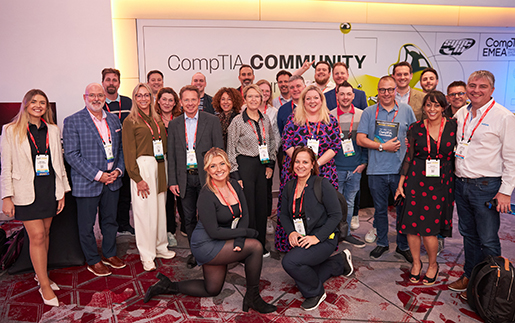 Good tech workers, especially in sought-after fields such AI and cybersecurity, are hard to find and even harder to replace. But the process can be a bit less challenging if you adopt some of the same technologies to attract, retain and upskill the right people.
Good tech workers, especially in sought-after fields such AI and cybersecurity, are hard to find and even harder to replace. But the process can be a bit less challenging if you adopt some of the same technologies to attract, retain and upskill the right people.
“When you’re dealing with a skills gap, natural business growth and evolving technology, you may need to try something new,” said Nancy Hammervik, moderator of a workforce panel, Transforming Talent Management in Modern Organisations, at the CompTIA EMEA Member and Partner Conference in London. “You can’t expect people to come to your website and see something posted. Today, you really need a dedicated strategy—you need a talent strategy just like a marketing strategy or any other strategy.”
One way to accomplish that is to leverage emerging technologies to upskill your current staff as well as to find new employees, said Steven Tytgat, CEO of Tyneso, a Belgian MSP with 30 employees.
“Everybody needs to train to get new skills. From service desk to tech engineers and security roles. They need to know new functions and new technology,” he said. Tyneso employees get five days a year for external training and a financial benefit for completing training, Tytgat said.
“You have to put in your agenda and what you’re studying. Learning is part of your job. We have financial benefit plans to do so,” he said. “We have daily and weekly meetings where we share information on what’s new, where we learned, where we still lack skills and how we can patch it up.”
Help Employees Help Themselves
Steven Capper, a member of the CompTIA board of directors, noted that incentivizing employees to learn is important because otherwise they get so focused on doing their job that education and training is easy to slip through the cracks.
“Half the problem is people making time themselves. That’s a real blocking event to overcome. You can talk about having sessions at lunchtime for example, but every time at the end of the [year], they haven’t found time. Find the time. Put [schedule] blockers in so you can have the time. See what’s out there,” Capper said.
Another challenge for employers is calculating how much learning time to give to employees and how to set a culture where learning and new ideas are not only accepted but encouraged, according to David James, chief learning officer at 360Learning.
“People will go with what’s accepted. If you get rewarded for being busy, people will focus on their work because otherwise they might be deemed that they have too much time on their hands,” James said. “There needs to be role modeling at work. People need to be rewarded for bringing insights into the organization. If it’s not rewarded then maintaining status quo is over-revered and then what is the motivation to learn? You need to reward people for insights they bring. Things are changing far too quickly and in a non-linear way compared to what they were. If you’re not moving forward, you’re moving backwards.”
Overcoming the Challenge of Keeping Pace
The tech industry is also innovating and evolving at a dizzying pace, where it’s difficult for small businesses like MSPs to keep pace, said Tytgat.
“We are too small to develop stuff ourselves. The only thing you can do is try to find smart people and give them time to learn. We look at new laws coming out and there’s a lot of traction from customers who need to have those skills to be compliant. We work towards that,” Tytgat said.
For example, AI solutions will replace 85 million jobs according to a World Economic Forum report, but innovation in AI will also create 97 million jobs. Of course we’re all still learning—and creating—the skills that will be necessary to fuel AI-powered solutions. And some of them won’t be tech skills at all.
“We used to look at hard skills. What OS do you know,” James said. “Today, we look at soft skills. We know it will be automated but a person will still be the link between a customer and our team to execute on it. We need more that technical translator business—it’s s still a people business.”
AI—What Else!—Can Accelerate the Process
AI is also a terrific tool to assess and map skills within an organization, James said. “We’ve already seen AI is accelerating an organization’s ability to close skills gaps. Skills mapping and investments in hiring can be a great deal better than before,” he said.
Finally, the most successful businesses might be the ones that instill a strong and positive culture toward learning and investing in employee growth, the panelists said.
“The key is to help people do what they’re trying to do,” said James. “We need to stop trying to skill learning products, not the needs of the individual. There needs to be a commitment to helping people.”
The most successful learning is “just in time, just enough and just for you,” said James. “Learning comes when you’re faced with a challenge and receive feedback. The greatest example recently was if I told you not to touch kettle. You might believe me but will learn when touch the kettle. If we can help people connect the dots, learning is a lot more successful.”
Get the Skills Assessment and Development Playbook for MSPs.

 Add CompTIA to your favorite RSS reader
Add CompTIA to your favorite RSS reader
.png?sfvrsn=16ffdb49_2)
